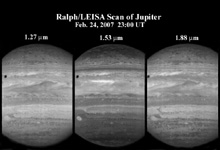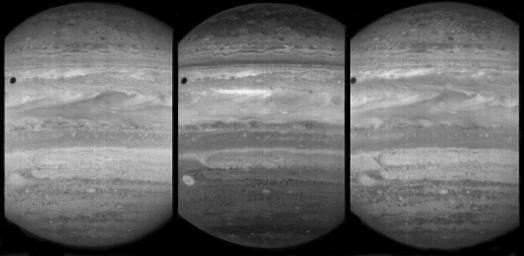
Annotated VersionOn February 24, 2007, the LEISA (pronounced "Leesa") infrared spectral imager in the New Horizons Ralph instrument observed giant Jupiter in 250 narrow spectral channels. At the time the spacecraft was 6 million kilometers (nearly 4 million miles) from Jupiter; at that range, the LEISA imager can resolve structures about 400 kilometers (250 miles) across.
LEISA observes in 250 infrared wavelengths, which range from 1.25 micrometers (µm) to 2.50 µm. The three images shown above from that dataset are at wavelengths of 1.27 µm (left), 1.53 µm (center) and 1.88 µm (right).
The bright areas in the image frames are caused by solar radiation reflected from clouds and hazes in Jupiter's atmosphere. Dark areas correspond to atmospheric regions where solar radiation is absorbed before it can be reflected. The dark circular feature in the upper left of all three images is the shadow of Jupiter's innermost large moon, Io.
Light at 1.53 µm (center frame) comes from relatively high in the atmosphere. The other two channels probe deeper atmospheric levels. Features that are bright in all three pictures come from high-altitude clouds. Features that are bright in the 1.27 and 1.88 µm channels, but darker in the 1.53-µm channel come from lower clouds. For example, there is an isolated circular feature (the "Little Red Spot") in the lower left of the 1.53-µm image. In the 1.27 and 1.88 µm data, this circular feature is surrounded by other structures. The implication is that the "Little Red Spot" is caused by a system that extends far up into the atmosphere, while other structures are lower.
At closest approach to Jupiter on February 28, at a distance of about 2.5 million kilometers (1.4 million miles), LEISA's resolution was about three times better than it was on February 24. LEISA images made at that far-better resolution are still stored in the spacecraft's data recorder, awaiting downlink from New Horizons.

 Planetary Data System
Planetary Data System













